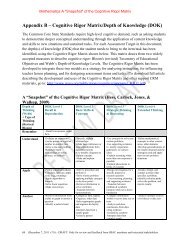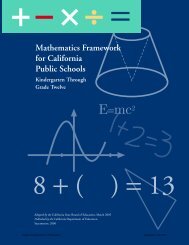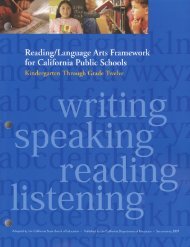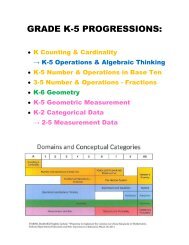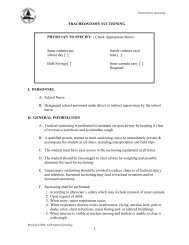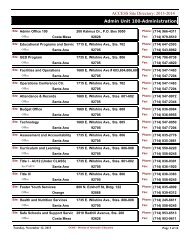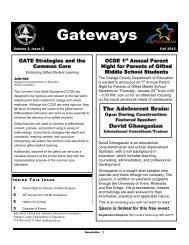The Promise and the Peril for Students with Disabilities - CalSTAT
The Promise and the Peril for Students with Disabilities - CalSTAT
The Promise and the Peril for Students with Disabilities - CalSTAT
You also want an ePaper? Increase the reach of your titles
YUMPU automatically turns print PDFs into web optimized ePapers that Google loves.
Assessment continued from page 3<br />
focus in special education had been on<br />
improving outcomes <strong>for</strong> students <strong>with</strong><br />
mild-to-moderate disabilities, Cali<strong>for</strong>nia<br />
had begun exp<strong>and</strong>ing this focus in<br />
2003 <strong>with</strong> <strong>the</strong> development <strong>and</strong> implementation<br />
of <strong>the</strong> Cali<strong>for</strong>nia Alternate<br />
Per<strong>for</strong>mance Assessment (CAPA), a<br />
consistent, statewide assessment system<br />
<strong>for</strong> students <strong>with</strong> significant cognitive<br />
impairments. <strong>The</strong>se students comprise<br />
approximately 1 percent of all students<br />
eligible <strong>for</strong> special education. <strong>The</strong><br />
CAPA measures students’ skills, however,<br />
not <strong>the</strong>ir knowledge or mastery<br />
of academic content. <strong>The</strong> development<br />
of <strong>the</strong> CAPA was followed in 2007 by<br />
<strong>the</strong> development <strong>and</strong> implementation<br />
of <strong>the</strong> Cali<strong>for</strong>nia Modified Assessment<br />
(CMA), which provides <strong>the</strong> same content<br />
as <strong>the</strong> CST, but <strong>with</strong> fewer words<br />
<strong>and</strong> three ra<strong>the</strong>r than four choices <strong>for</strong><br />
an answer. <strong>The</strong> CMA was intended to<br />
bridge <strong>the</strong> gap between <strong>the</strong> CST <strong>and</strong><br />
<strong>the</strong> CAPA.<br />
<strong>The</strong>se four monumental changes<br />
have greatly improved <strong>the</strong> way we educate<br />
<strong>and</strong> assess students <strong>with</strong> disabilities.<br />
<strong>The</strong>y do not, however, completely<br />
address <strong>the</strong> twenty-first-century skills<br />
that students will need in order to<br />
be competitive in a global economy.<br />
Without question our current State<br />
Testing <strong>and</strong> Reporting (STAR) system—which<br />
includes <strong>the</strong> CST, CMA,<br />
<strong>and</strong> CAPA—is antiquated <strong>and</strong> in need<br />
of a complete overhaul. For example,<br />
<strong>the</strong> tests are administered via paper <strong>and</strong><br />
pencil <strong>and</strong> are not adaptable to each<br />
student’s skill level. Also, <strong>the</strong>se assessments<br />
are unique to our state <strong>and</strong> may<br />
not accurately provide <strong>for</strong> comparisons<br />
<strong>with</strong> student per<strong>for</strong>mance in o<strong>the</strong>r<br />
states <strong>and</strong> nations. Ano<strong>the</strong>r problem is<br />
that <strong>the</strong> tests are summative, administered<br />
at <strong>the</strong> end of <strong>the</strong> school year;<br />
<strong>and</strong> <strong>the</strong> results are not known until <strong>the</strong><br />
following year, precluding any chance<br />
<strong>for</strong> teachers to reteach or remediate<br />
identified areas of need. Fortunately,<br />
as m<strong>and</strong>ated in Assembly Bill 250,<br />
a group of educators selected by <strong>the</strong><br />
Superintendent of Public Instruction<br />
currently is meeting every month to<br />
develop suggestions <strong>for</strong> an entirely new<br />
statewide assessment system to be presented<br />
to <strong>the</strong> State Board of Education.<br />
In<strong>for</strong>mation on AB 250<br />
is available at<br />
www.cde.ca.gov/ta/tg/sa/<br />
ab250.asp.<br />
Common Core State St<strong>and</strong>ards<br />
<strong>The</strong> fifth monumental change in<br />
special education is underway <strong>with</strong><br />
<strong>the</strong> development <strong>and</strong> implementation<br />
of <strong>the</strong> Common Core State St<strong>and</strong>ards<br />
(CCSS) <strong>and</strong> <strong>the</strong> new assessment system<br />
that will be used to monitor student<br />
progress toward meeting those st<strong>and</strong>ards.<br />
<strong>The</strong> a<strong>for</strong>ementioned changes<br />
provide a solid foundation <strong>for</strong> what is<br />
likely to be an entirely new <strong>and</strong> more<br />
inclusive method of teaching <strong>and</strong> assessing<br />
students <strong>with</strong> disabilities. <strong>The</strong><br />
shift from “all students proficient by<br />
2014” under NCLB to <strong>the</strong> College <strong>and</strong><br />
Career Readiness (CCR) <strong>the</strong>me of <strong>the</strong><br />
All students [will] have<br />
<strong>the</strong> opportunity to learn this<br />
valued content <strong>and</strong> show what<br />
<strong>the</strong>y know <strong>and</strong> can do.<br />
CCSS represents a positive change that<br />
is much more promising <strong>for</strong> each student<br />
entering adult life. <strong>The</strong> academic<br />
content in <strong>the</strong> CCSS focuses on twentyfirst-century<br />
skills, which will certainly<br />
help students prepare <strong>for</strong> a global<br />
economy <strong>and</strong> workplace.<br />
Smarter Balanced<br />
Assessment Consortium<br />
An integral part of <strong>the</strong> CCSS is <strong>the</strong><br />
Smarter Balanced Assessment Consortium<br />
(SBAC), which is currently developing<br />
assessments that will replace<br />
both <strong>the</strong> CST <strong>and</strong> CMA. <strong>The</strong> SBAC<br />
work has been adopted <strong>for</strong> use in Cali<strong>for</strong>nia<br />
as well as in 26 o<strong>the</strong>r states.<br />
<strong>The</strong> Smarter Balanced<br />
Assessment Consortium<br />
can be found at<br />
www.smarterbalanced.org/.<br />
Directly aligned to <strong>the</strong> CCSS, <strong>the</strong><br />
proposed Smarter Balanced assessments<br />
are computer adaptive <strong>and</strong> adjust<br />
to each student’s skill level based<br />
on his or her response to each test<br />
item. <strong>The</strong>se assessments will include a<br />
summative or end-of-year test, along<br />
<strong>with</strong> interim assessments <strong>and</strong> <strong>the</strong> option<br />
of <strong>for</strong>mative assessments to help<br />
shape <strong>and</strong> direct instruction throughout<br />
<strong>the</strong> school year (WestEd, 2012).<br />
Ano<strong>the</strong>r key feature of <strong>the</strong> Smarter<br />
Balanced assessments is that students,<br />
teachers, <strong>and</strong> parents will receive <strong>the</strong><br />
results of <strong>the</strong>se assessments in a timely<br />
manner that not only will help in<strong>for</strong>m<br />
instruction but will direct <strong>the</strong> need<br />
<strong>for</strong> any remediation.<br />
Many of <strong>the</strong> separate accommodations<br />
<strong>and</strong> modifications that were used<br />
in <strong>the</strong> administration of <strong>the</strong> CST <strong>and</strong><br />
CMA are being built into <strong>the</strong> Smarter<br />
Balanced assessments (Shah, 2011).<br />
A computer adaptive feature—<strong>and</strong><br />
<strong>the</strong> use of technology in general—<br />
will enable an array of such options<br />
as enlarged print, highlighting of<br />
reading passages, use of a scribe, <strong>and</strong><br />
use of a calculator to occur directly at<br />
each computer. According to Stanley<br />
Rabinowitz, Director of Assessment<br />
<strong>and</strong> St<strong>and</strong>ards Development Services<br />
<strong>and</strong> of <strong>the</strong> Assessment <strong>and</strong> Accountability<br />
Comprehensive Center at<br />
WestEd, “To achieve <strong>the</strong> goal that all<br />
students leave high school ready <strong>for</strong><br />
college <strong>and</strong> career, Smarter Balanced<br />
will ensure that assessment <strong>and</strong> instruction<br />
embody <strong>the</strong> Common Core<br />
State St<strong>and</strong>ards <strong>and</strong> that all students,<br />
regardless of disability, language, or<br />
subgroup status, have <strong>the</strong> opportunity<br />
to learn this valued content <strong>and</strong> show<br />
what <strong>the</strong>y know <strong>and</strong> can do” (WestEd,<br />
2012). WestEd is <strong>the</strong> project management<br />
partner <strong>for</strong> <strong>the</strong> multistate<br />
implementation of <strong>the</strong> Smarter Balanced<br />
assessments.<br />
4 u <strong>The</strong> Common Core State St<strong>and</strong>ards Summer 2012 u <strong>The</strong> Special EDge






